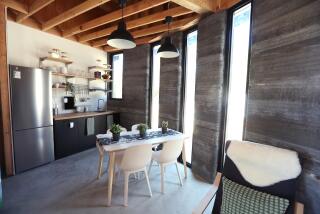Made for shade: Curtains and blinds move to the outside of houses
- Share via
Kitchens moved outside. So did rugs, lamps and the dining table. Now we even have the outdoor bed. It was inevitable that curtains and window shades would follow suit.
At the 2013 Solar Decathlon, the university design competition on view through Sunday at the Orange County Great Park in Irvine, the phenomenon is driven by function, not style. Several teams have deployed louvers, blinds and screens on the homes’ exteriors to block sunlight and its accompanying heat before they enter the house, not after they have passed through a window or glass door. The net effect: The homes need less air conditioning to stay comfortable.
Here’s a quick look at different exterior shading strategies and technologies seen at the Solar Decathlon, where 19 houses will reopen to the public Thursday:
App-operated shades. Team Ontario devised motorized shades made of outdoor canvas that rises from the bottom, complementing the shading from the awning above. The shades operate remotely via Android app. They’re invisible when retracted, tucked neatly behind the house’s siding, and when they’re deployed, they make interior window treatments unnecessary. (See related video of the shades in action.)
Self-adjusting louvers. Team Capitol DC outfitted its house with green powder-coated blinds that automatically open and close depending on the weather, moderating indoor conditions without the homeowner lifting a finger. “There is a nickel- and titanium-based wire that’s in there that passively actuates once it gets to a certain temperature,” student construction manager Kyle Noell said. In winter, the louvers slip into a pocket slot, letting the sun shine in.
PHOTO GALLERY: Exterior shades, curtains and screen
Laser-cut screen. To provide relief from the relentless desert sun, students from the University of Nevada Las Vegas designed rusted sheet-metal screens that have been laser cut with the perforated silhouette of a mesquite tree. Team member Alexia Chen said students took a photo of the tree, Photoshopped it to get the pixilated pattern they wanted, then turned over the digital file to a metal shop for the laser cutting. “That is something that a homeowner could do,” Chen said, noting how consumers can more easily find fabricators to laser-cut custom patterns in metal, wood or acrylic. She added with a laugh: “If you wanted to put your face on it, you could.”
Exterior curtain. Whereas UNLV went hard, Team Austria went soft. Billowy white curtains wrap parts of the Vienna University of Technology entry, providing shade when the sun is lower in the sky and additional privacy whenever it’s wanted, all without impeding ventilation. The fluttering of the textile also acts as a nice counterpoint to the straight lines of the house. Combined with retractable sunshades over lounging decks, the giant curtains proves to be a smart solution for indoor-outdoor living.
SOLAR DECATHLON 2013: Team profiles, contest results, design trends
Skylight shade. The USC entry in the Solar Decathlon centers on a large, operable skylight that not only brightens the house but also serves as a thermal chimney, pulling out hot air and drawing in cooler prevailing breezes through glass doors. The central skylight and a smaller one in the bathroom were designed with retractable shades, shielding interiors when the sun is overhead without disrupting the passive ventilation system.
Wood shell. Czech Technical University students, by comparison, went low tech by wrapping their house in a slatted wood shade canopy. Beyond the design’s functional benefits, the simple aesthetics are arresting. Walking in the pocket between the solid house and the slatted shade structure borders on ethereal, an interesting world between light and dark, openness and enclosure, inside and outside.
Twitter: @cnakano | Email: [email protected]
JOIN THE CONVERSATION:
@latimeshome | pinterest.com/latimeshome | facebook.com/latimeshome | facebook.com/latimesgarden







